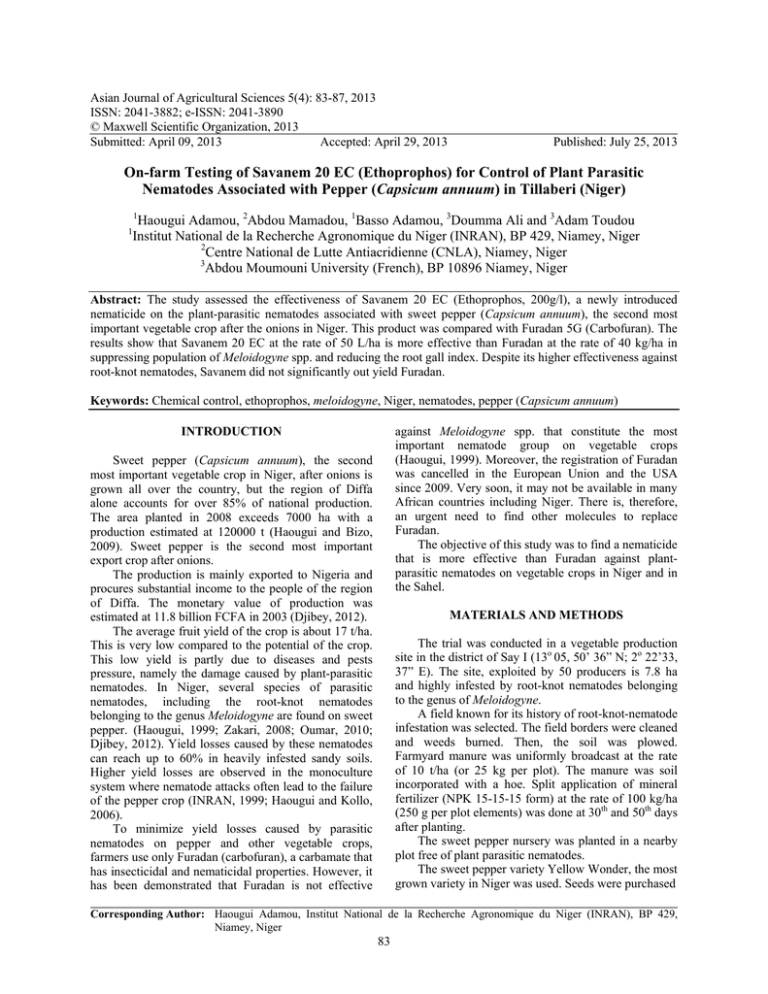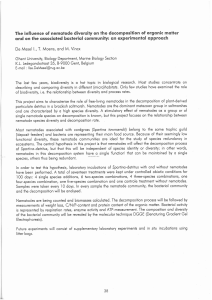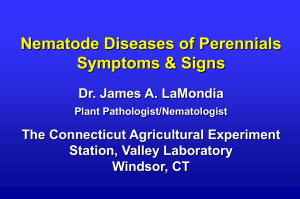Asian Journal of Agricultural Sciences 5(4): 83-87, 2013
advertisement

Asian Journal of Agricultural Sciences 5(4): 83-87, 2013 ISSN: 2041-3882; e-ISSN: 2041-3890 © Maxwell Scientific Organization, 2013 Submitted: April 09, 2013 Accepted: April 29, 2013 Published: July 25, 2013 On-farm Testing of Savanem 20 EC (Ethoprophos) for Control of Plant Parasitic Nematodes Associated with Pepper (Capsicum annuum) in Tillaberi (Niger) 1 Haougui Adamou, 2Abdou Mamadou, 1Basso Adamou, 3Doumma Ali and 3Adam Toudou Institut National de la Recherche Agronomique du Niger (INRAN), BP 429, Niamey, Niger 2 Centre National de Lutte Antiacridienne (CNLA), Niamey, Niger 3 Abdou Moumouni University (French), BP 10896 Niamey, Niger 1 Abstract: The study assessed the effectiveness of Savanem 20 EC (Ethoprophos, 200g/l), a newly introduced nematicide on the plant-parasitic nematodes associated with sweet pepper (Capsicum annuum), the second most important vegetable crop after the onions in Niger. This product was compared with Furadan 5G (Carbofuran). The results show that Savanem 20 EC at the rate of 50 L/ha is more effective than Furadan at the rate of 40 kg/ha in suppressing population of Meloidogyne spp. and reducing the root gall index. Despite its higher effectiveness against root-knot nematodes, Savanem did not significantly out yield Furadan. Keywords: Chemical control, ethoprophos, meloidogyne, Niger, nematodes, pepper (Capsicum annuum) against Meloidogyne spp. that constitute the most important nematode group on vegetable crops (Haougui, 1999). Moreover, the registration of Furadan was cancelled in the European Union and the USA since 2009. Very soon, it may not be available in many African countries including Niger. There is, therefore, an urgent need to find other molecules to replace Furadan. The objective of this study was to find a nematicide that is more effective than Furadan against plantparasitic nematodes on vegetable crops in Niger and in the Sahel. INTRODUCTION Sweet pepper (Capsicum annuum), the second most important vegetable crop in Niger, after onions is grown all over the country, but the region of Diffa alone accounts for over 85% of national production. The area planted in 2008 exceeds 7000 ha with a production estimated at 120000 t (Haougui and Bizo, 2009). Sweet pepper is the second most important export crop after onions. The production is mainly exported to Nigeria and procures substantial income to the people of the region of Diffa. The monetary value of production was estimated at 11.8 billion FCFA in 2003 (Djibey, 2012). The average fruit yield of the crop is about 17 t/ha. This is very low compared to the potential of the crop. This low yield is partly due to diseases and pests pressure, namely the damage caused by plant-parasitic nematodes. In Niger, several species of parasitic nematodes, including the root-knot nematodes belonging to the genus Meloidogyne are found on sweet pepper. (Haougui, 1999; Zakari, 2008; Oumar, 2010; Djibey, 2012). Yield losses caused by these nematodes can reach up to 60% in heavily infested sandy soils. Higher yield losses are observed in the monoculture system where nematode attacks often lead to the failure of the pepper crop (INRAN, 1999; Haougui and Kollo, 2006). To minimize yield losses caused by parasitic nematodes on pepper and other vegetable crops, farmers use only Furadan (carbofuran), a carbamate that has insecticidal and nematicidal properties. However, it has been demonstrated that Furadan is not effective MATERIALS AND METHODS The trial was conducted in a vegetable production site in the district of Say I (13o 05, 50’ 36” N; 2o 22’33, 37” E). The site, exploited by 50 producers is 7.8 ha and highly infested by root-knot nematodes belonging to the genus of Meloidogyne. A field known for its history of root-knot-nematode infestation was selected. The field borders were cleaned and weeds burned. Then, the soil was plowed. Farmyard manure was uniformly broadcast at the rate of 10 t/ha (or 25 kg per plot). The manure was soil incorporated with a hoe. Split application of mineral fertilizer (NPK 15-15-15 form) at the rate of 100 kg/ha (250 g per plot elements) was done at 30th and 50th days after planting. The sweet pepper nursery was planted in a nearby plot free of plant parasitic nematodes. The sweet pepper variety Yellow Wonder, the most grown variety in Niger was used. Seeds were purchased Corresponding Author: Haougui Adamou, Institut National de la Recherche Agronomique du Niger (INRAN), BP 429, Niamey, Niger 83 Asian J. Agric. Sci., 5(4): 83-87, 2013 on the local market. Seedlings were transplanted in the test plots when they were four weeks old. Distance between rows was 0.8 m and intra row distance was 0.4m. Two nematicides, Savanem 20 EC and Furadan 5 G were used. They were applied before planting. Savanem 20 EC was applied at the rate of 50 L/ha in the afternoon, when the weather was calm with temperature between 28 and 30°C. The slurry of the nematicide was prepared in a 15 L knapsack sprayer and then uniformly spread on the test plot. The reference nematicide (granular carbofuran) was applied at the rate of 40 kg/ha (the recommended dose) and incorporated into the soil before watering. Absolute control plots, without any nematicide were watered with the same volume of water (15 L). The three treatments were laid out in randomized complete blocks with four repetitions. Experimental plots measured 25 m2 (5 m×5 m). The distance between plots was 2 m. Blocks were also separated a 2 m band. The nematode pollution densities were estimated before planting and applying the nematicides and at 45 and 65 Days after Transplanting (DAT). To determine the initial nematode population densities, 20 samples were taken throughout the test area. Each sample was obtained by bulking 5 subsamples collected in zigzag pattern (Barker, 1985) and taking an aliquot. Subsamples were taken at depth of 5-20 cm with a trowel. Importance of each nematode species was estimated using the method of Fortuner and Merny (1973). According to these authors, a species is considered common when it is present in over 30% of the samples; it is considered abundant when its density is higher than 300 individuals per dm3. The abundance was log transformed (Log (x+1)). To estimate the nematode population at 45 and 65 DAT, 10 plants were randomly taken in the central rows and soil samples were collected in the rhizosphere of these plants. Nematodes were extracted from soil using the Seinhorst (1962). Root gall indexes were assessed using the scale of Taylor and Sasser (1978): 0 = no galls, 1 = 1-2 galls, 2 = 3-10 galls, 3 = 11-30 galls, 4 = 31-100 galls, 5 = more than 100 galls. Fruit yields were estimated by harvesting the central rows; the border rows were excluded. The cumulative fruit weight from three harvests were computed and used to estimate the yields. Data were analyzed using the statistical package Statistix V8. Analysis of Variance (ANOVA) and the LSD mean separation test at 5% significant level were performed. RESULTS AND DISCUSSION Nematode populations: • The initial population density of parasitic nematodes: Four genera of parasitic nematodes were encountered: Meloidogyne, Helicotylenchus, Tylenchus and Tylenchorhynchus (Fig. 1). This situation is typical of tropical and subtropical areas where crops are usually attacked by several species of parasitic nematodes (Cadet et al., 1994) instead of a single species as it occurs in most temperate regions where monoculture is predominant. The site-specific diversity is low compared to those reported by other authors on pepper production sites (Zakari, 2008; Oumar, 2010; Djibey, 2012). According to the diagram of Fortuner and Merny (1973) (Fig. 1), among the four genera of parasitic nematodes found, only Meloidogyne was both frequent and abundant. Helicotylenchus and Tylenchorhynchus were frequent but not abundant, while Tylenchus was neither frequent nor abundant. Meloidogyne spp. Fig. 1: Frequency/Abundance of parasitic nematodes found in the site (initial population) 84 Asian J. Agric. Sci., 5(4): 83-87, 2013 Table 1: Evolution of Meloidogyne populations in treated and untreated plots (individuals/dm3) Population Population Treatments Initial population 45 DAT 65 DAT Control 458 3302a 2641a Savanem 458 210c 122c Furadan 458 1122b 1122b Analysis of variance and the LSD test was done on log transformed densities, means are transformed back to the original units; Numbers with the letter are not significantly different (p≤0.05) Tylenchus Tylenchorynchus Helicotylenchus Meloidogyne 100% 90% 80% 70% 60% The highest inhibition rate of multiplications by Savanem was observed on the genus Meloidogyne (Table 1); this showed the efficacy of this product in protecting sweet peeper in the site. The root-knot nematodes are the most dangerous for the Solanaceous crops. In contrast, Furadan did not inhibit the increase of the development of the Meloidogyne. In fact, in early work, carbofuran (active ingredient of Furadan) was more effective on ectoparasitic nematodes. Haida et al. (1993) a significant decrease of the populations of nematodes on sugarcane after application of carbouran; these nematodes were mostly ectoparasites. Qureshi et al. (2002) reported that carbofuran was effective against a community of plant-parasitic nematodes community consisting essentially of ectoparasites such as Basiria ritteri, Hoplolaimus Columbus, Hemicriconemoides mangiferae, Xiphinema americanum and Helicotylenchus dyshistera on sugarcane too. However, several authors showed that cabofuran has no effect on the genus Meloidogyne on tomato (Haougui 1999; Cadet, 1990; Germani, 1979; Pandey, 1994). Irrespective of the treatments, nematode populations have declined in all test plots at the 65th DAT (Table 1). The evolution of nematode populations, namely those belonging to the genus Meloidogyne followed the classical trend observed on the Solanaceaes (DeGuiran, 1980). During the first weeks after planting, Meloidogyne populations increase exponentially then declined (Fig. 3). The decline is caused by changes in root physiology that trigger the nematode eggs to enter into diapauses. Also, at the same time the larvae move out of the root system and migrate into the deeper layers of the soil where they escape sampling (Prot, 1980). It should be noted that Tylenchus completely disappeared from all plots (treated or untreated). This phenomenon is not understood. 50% 40% 30% 20% 10% 0% Fig. 2: Parasitic nematode community structure (initial population) represented nearly 45% of the plant-parasitic nematodes community found in the site (Fig. 2). The importance of this genus indicated that the site was suitable for conducting such experiments, because this group of nematodes is the most destructive one on vegetable crops in general and on Solanaceous crops such as peppers, tomatoes, eggplant in particular. Haougui et al. (2003) showed that root-knot nematodes belonging to the genus Meloidogyne can cause yield losses up to 55% on tomato. The situation encountered in this study is characteristic of the structure of nematode communities on pepper in Niger reported by several authors (Zakari, 2008; Oumar, 2010; Djibey, 2012). • Evolution of nematode populations at 45 and 65th DAT: The treatments effects on Meloidogyne populations densities at 45 and 65 DAT are significantly different (p≤0.05) (Table 1). In the untreated plots the Meloidogyne population densities increased exponentially; but in the nematicide-treated plots the rate of increase was low. Copared to Furadan, Savanem strongly inhibited the multiplication of the nematodes. The multiplication rates of the nematode, MR (computed as the ratio of nematode population density at 45 DAT over the initial population densities) was 4.1 for the control treatment. This rate was reduced five times by application of Savanem at 50 L/ha (>82% reduction in comparison with the check). In the reference product, Furadan reduced the multiplication rate by 58.8%, when compared to the check. Savanem gave a good control of the nematodes, as the MR was all cases less than 1. This means that Savanem reduces the plant efficiency for allowing the rootknot nematodes to reproduce (Abd-Rahman et al., 2008). • 85 Root galls index: Root gall indexes were assessed 65 DAT. The differences in the root gall index among the nematicide treatments are significant (p≤0.05) (Fig. 3). Application of Savanem resulted in the lowest average root gall index, 1.0 and the control treatment gave the highest mean of rootgall index, 4.5. Results with Furadan were intermediate. The reduction rate of root gall index was 76.9 and 38.2% for Savanem and for Carbofuran, respectively. Asian J. Agric. Sci., 5(4): 83-87, 2013 ACKNOWLEDGMENT The authors thank the Savana-France Company for financing the study. Thanks are also due to Hame Abdou Kadi Kadi (ICRISAT Niger) and Abdourhamane I. Kollo (CORAF Senegal) for helping us in the improvement of the document. REFERENCES Abd-Rahman, M., Y. Najah and M.B. Umikalsum, 2008. Preliminary screening for Meloidogyne incognita resistance in selected Psidium species. J. Trop. Agric. Fundamen. Sci., 36(2): 1-8. Barker, K.R., 1985. Sampling Nematode Communities. In: Barker, K.R., K.R.C.C. Carter and J.N. Sasser (Eds.), an Advanced Treatise on Meloidogyne. Methodology, North Carolina State University Graphics, Raleigh, North Carolina, USA, 2: 3-14. Cadet, P., 1990. Influence of some insecticides on the yield of tomato and multiplication of parasitic nematodes in Martinique. Agric. J. Antilles Guyana (French), 10: 42-48. Cadet, P., E. Van Den Berg and A. Delatte, 1994. Comparison of some nematode populations of the Lesser Antilles. Geographica, 70: 125-138. DeGuiran, G., 1980. Parasitic nematodes of vegetable crops in Senegal. Cahier ORSTOM, Série Biol., 11: 210-229. Djibey, R., 2012. Characterization of parasitic nematodes communities associated with pepper in the Diffa and Dosso regions and Reaction of two landraces of pepper and Pasteuria penetrans to Meloidogyne sp in greenhouse. M.Sc. Thesis, AGRHYMET Regional Centre, Niamey (Niamey). Fortuner, R. and G. Merny, 1973. Plant Parasitic nematodes associated with rice roots in low Casamance (Senegal) and Gambia. Cahier ORSTOM, Série Biol. Nématol., 21: 4-43. Germani, G., 1979. Furadan action on the vegetative development of peanut. Oléagineux, 34: 457-458. Haida, M.G., M.G. Samad and M.L. Waris, 1993. Efficacy of organic soil amendments and carborfuran on plant parasitic nematodes: Yield and juice quality of sugarcane. Indian Sugar, 42: 925-929. Haougui, A., 1999. Plant parasitic nematodes associated with vegetables in Niger: Importance and the control measures using nematicidal properties of plants. Ph.D. Thesis, University of Dschang, Cameroon. Haougui, A., E. Sarr and I. Alzouma, 2003. Pathogeny of Meloidogyne javanica (Treub, 1885; Chitwood, 1949) on tomato in greenhouse. Ann. Univ., Abdou Moumouni (French), 7: 14-24. Fig. 3: Root gall indices on treated and untreated plots [Numbers with the same letter are not significantly different (p≤0.05)] Table 2: Average yields of sweet pepper variety yellow wonder in nematodes infested soils treated with two nematicides Treatments Yield (t/ha) Control 17.50c Savanem (50 l/ha) 24.00ab Furadan (40 kg/ha) 21.10b Numbers with the letter are not significantly different (p ≤ 0.05) • Yield: Yields of the plots treated with Furadan and Savanem are significantly higher than yields of the untreated plots (Table 2). Savanem has produced the highest average yield 24.0 t/ha; but it is not significantly different from the average yield obtained with Furadan, 21.1 t/ha. This may be caused by the fact that Furadan has a crop growth stimulating effect; the crop growth regulator effect may compensate the low nematicidal effectiveness of Furandan on root-knot nematodes (Germani, 1979). In addition Furadan, a systemic compound with 50 days remanence can protect the whole pepper plant during most of the vegetative period against insect pests. Savanem increased the average yield by 37.1% and Furadan by 20.6%. CONCLUSION Savanem 20 EC, at the dose of 50 L/ha is effective again the community of parasitic nematodes on sweet pepper. Its effectiveness was particularly demonstrated on root-knot nematodes belonging to the genus Meloidogyne, a group of nematodes that is a limiting factor to the production of Solanaceous crops in general in the Sahel and sweet peppers in particular. At the applied rate it has given a better control of the populations of plant parasitic nematodes than the reference nematicide, Furadan 5 G used in this test. The advantage of Savanem 20 EC is a greater reduction of soil population nematodes than what can be obtained with Furadan. This allows a better protection of the succeeding crop. 86 Asian J. Agric. Sci., 5(4): 83-87, 2013 Haougui, A. and A.I. Kollo, 2006. Nematodes, unseen ennemis of vegetables producers. L’irrigant, 1: 18-19. Haougui, A. and N.M. Bizo, 2009. Characterization of Plant Parasitic Nematodes Communities Associated with Pepper on the Aguie KKM Project Sites of Maradi. KKM Project, Maradi. INRAN, 1999. Assessment report of 1998 crop protection activities. Niamey (Niger). Oumar, H., 2010. Characterization of plant parasitic nematodes communities associated with Solanaceaous crops in the periurban area of Niamey. M.S. Thesis, University of Ouagadougou, Burkina Faso. Pandey, R., 1994. Comparative performance of oil seed cake and pesticides in the management of root-knot nematodes (Meloidogyne incognita) of davana. Nematol. Mediterranea, 32: 17-19. Prot, J.C., 1980. Migration of plant parasitic nematodes toward plant roots. Révue Nematologie, 3: 305-318. Qureshi, M.A., R.S. Ahmed, G.S. Shah, A.L. Khanzada and K.I. Rajput, 2002. Studies on chemical control of plant parasitic nematodes associated with sugarcane Saccharum officinarum Linn. Pak. J. Plant Pathol., 2: 44-47. Seinhorst, J.W., 1962. Modifications of the elutriation method for extracting nematodes from soil. Nematologica, 8: 117-128. Taylor, A.L. and J.N. Sasser, 1978. Biology, Identification and Control of Root-Knot Nematodes (Meloidogyne species). North Carolina State University Press, Raleigh. Zakari, A., 2008. Population structure of plant parasitic nematodes of vegetable crops in the vegetable belt of Niamey. M.Sc. Thesis, University of Bamako, Mali. 87







